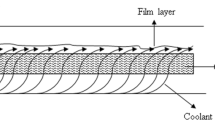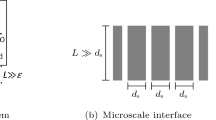Abstract
A transient, one-dimensional numerical model is developed to describe the processes of transpiration cooling and ablation of the porous matrix used for the cooling. This model is based on the assumption of local thermal equilibrium. The problem of moving boundary due to ablation of the porous matrix is treated by the front-fixing method. This paper discusses the results of numerical simulations under different conditions and control parameters of ablation process. It was found that cooling effects and ablation processes are influenced by the coolant mass flow rate, the intensity of the heat flux, and the initial temperature at the start of transpiration cooling. In additional to the above three parameters, the Stefan number and the Biot number can also influence the transient cooling process, control ablative thickness of the porous plate by the reduction of ablative speed and duration, respectively.












Similar content being viewed by others
Abbreviations
- a :
-
specific surface area of porous matrix
- c :
-
specific heat capacity [J/(kg K)]
- D :
-
hydraulic diameter of coolant channel (m)
- k :
-
thermal conductivity [W/(m K)]
- s 0 :
-
initial plate thickness (m)
- d p :
-
characteristic size of porous matrix (m)
- h :
-
heat transfer coefficient [W/(m2K)]
- s :
-
ablation thickness (m)
- \(\tilde{S}\) :
-
dimensionless thickness
- T :
-
temperature (K)
- θ:
-
dimensionless temperature
- v :
-
velocity (m/s)
- t :
-
time (s)
- τ:
-
dimensionless time
- y :
-
coordinate
- Y :
-
dimensionless coordinate
- \(\dot{q}\) :
-
heat flux (W/m2)
- Q :
-
dimensionless heat flux
- \(\dot{m}_{\rm f}\) :
-
coolant mass flow rate [kg/(m2 s)]
- M :
-
dimensionless coolant flow rate
- L :
-
latent heat of solid material (J/kg)
- Ste:
-
Stefan number
- Pr:
-
Prandtl number
- Bi:
-
Biot number
- ɛ:
-
porosity
- ρ:
-
density (kg/m3)
- μ:
-
viscosity, (kg/m s)
- α:
-
thermal diffusivity (m2/s)
- 0:
-
initial time
- f:
-
coolant fluid
- c:
-
constant/coolant at entry of channel
- eff:
-
effective
- s:
-
solid matrix
References
Hartnett JP, Eckert ERG (1957) Mass transfer cooling in a laminar boundary layer with constant fluid properties. Trans Am Soc Mech Eng 79:247–254
Choi SH, Scotti SJ, Song KD, Reis H (1997) Transpiration cooling of a scram jet engine combustion chamber, the 32th AIAA thermophysics conference, Atlanta, Georgia, 1997, AIAA 97-2576
Glass DE, Dilley AD. Numerical analysis of convection/transpiration cooling, NASA/TM −1999–209828
Andoh YH, Lips B (2003) Predication of porous walls thermal protection by effusion or transpiration cooling: an analytical approach. Appl Thermal Eng 23:1947–1958
Trevino C, Medina A (1999) Analysis of the transpiration cooling of a thin porous plate in a hot laminar convective flow. Eur J Mech B Fluids 18(2):245–260
Landis JA, Bowman WJ. Numerical study of a transpiration cooled rocket nozzle, AIAA Paper 96–2580
Keener D, Lenertz J, Bowersox R, Bowman J (1995) Transpiration cooling effects on nozzle heat transfer and performance. J Spacecr Rockets 32:981–985
Lewis DJ, Anderson LP. Effects of melt-layer formation on ablative materials exposed to highly aluminized rocket motor plumes, AIAA Paper 98–0872
Yang BC, Cheung FB. Numerical investigation of thermal–chemical and mechanical erosion of ablative materials, AIAA Paper 93–2045
Amiri A, Vafai K (1995) Effects of boundary conditions on non-darcian heat transfer through porous media and experimental comparisons. Numer Heat Transfer Part A 27:651–664
Amiri A, Vafai K (1998) Transient analysis of incompressible flow through packed bed. Int J Heat Mass Transfer 41:4259–4279
Wakao N, Kaguei S (1982) Heat and mass transfer in packed beds. Gordon and Breach Science Publishers Inc., New York
Kim SJ, Jang SP (2002) Effects of the Darcy number, the Prandtl number, and the Reynolds number on local thermal non-equilibrium. Int J Heat Mass Transfer 45:3885–3896
Kar KK, Dybbs A (1982) Internal heat transfer coefficient of porous metals. In: ASME proceedings of the winter annual meeting, Phoenix, Az. 1982, pp 81–91
Glass DE, Dilley AD (2001) Numerical analysis of convection/transpiration cooling. J Spacecr Rockets 38(1):15–20
Landis JA, Bowman WJ (1996) Numerical study of a transpiration cooled rocket nozzle, AIAA, ASME, SAE, and ASEE, joint propulsion conference and exhibit, 1996, AIAA Paper 96–2580
Stefan J (1889) Ueber die Theorie der Eisbildung, insbesondere ueber die Eisbildung im Palarmeere, Wien. Akad Mat Naturw 98(11a):965–983
Landau HG (1950) Heat conduction in a melting solid. Q Appl Math 8:81–94
Zhang YW, Faghri A (1999) Melting of a subcooled mixed powder bed with constant heat flux heating. Int J Heat Mass Transfer 42:775–788
Christoper DM (2001) Comparison of interface-following techniques for numerical analysis of phase-change problem. Numer Heat Transfer Part B 39:189–206
Khosla PK, Rubin SG (1974) A diagonally dominant second order accurate implicit scheme. Comput Fluid 2:207–209
Gonzo EE (2002) Estimating correlations for the effective thermal conductivity of granular materials. Chem Eng J 90:299–302
Acknowledgements
The financial support provided by NSFC (No. 90305006) and EMNSFA (No. 2004kj365zd) is greatly appreciated. One of the authors (Jianhua Wang) is also grateful for the financial support provided by the Foundation of the Education Ministry of China for the Returned Overseas Scholars.
Author information
Authors and Affiliations
Corresponding author
Rights and permissions
About this article
Cite this article
Wang, J., Wang, H., Sun, J. et al. Numerical simulation of control ablation by transpiration cooling. Heat Mass Transfer 43, 471–478 (2007). https://doi.org/10.1007/s00231-006-0130-x
Received:
Accepted:
Published:
Issue Date:
DOI: https://doi.org/10.1007/s00231-006-0130-x




